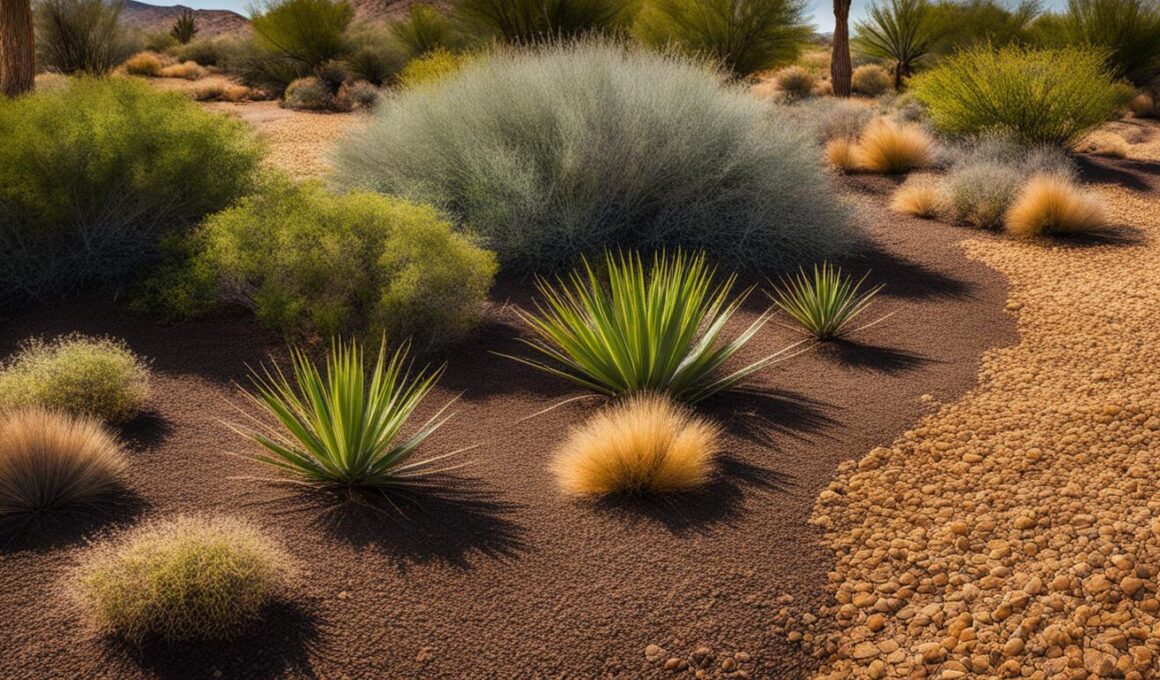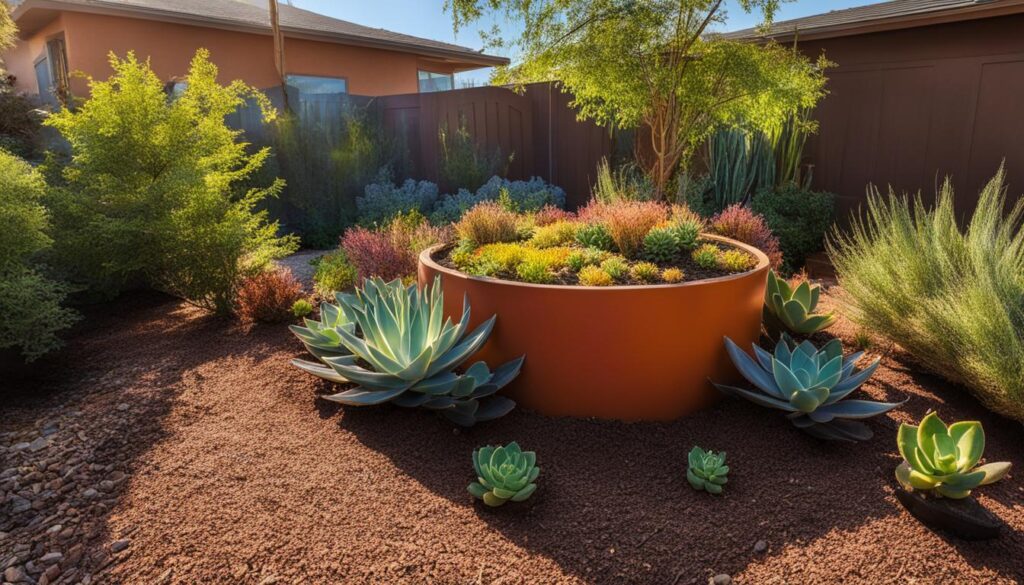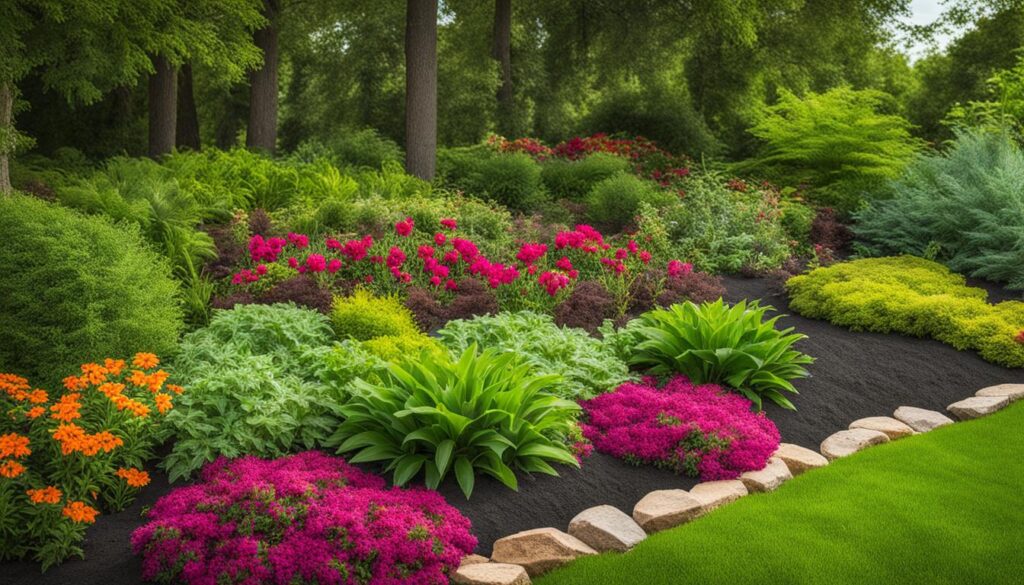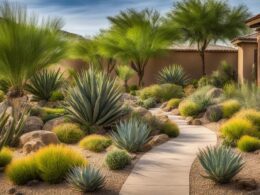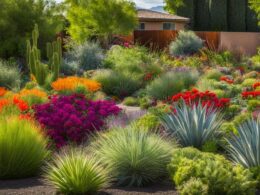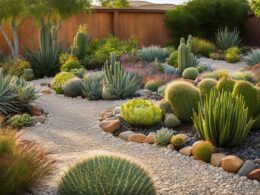When it comes to xeriscaping, mulching offers a wide range of benefits that can help you create a beautiful and sustainable garden. Mulching not only conserves water but also enriches the soil and controls weeds, making it an essential practice for any xeriscaper.
Key Takeaways:
- Mulching in xeriscaping helps conserve water by reducing the need for irrigation.
- Mulch enriches the soil by providing organic matter and improving moisture retention.
- Using mulch acts as a natural weed barrier, reducing the need for chemical herbicides and manual weeding.
- By mulching in xeriscaping, you can not only save money on water bills but also contribute to environmental sustainability.
- Overall, mulching in xeriscaping is a wise choice for creating beautiful and sustainable gardens while preserving water resources and promoting soil health.
Xeriscaping: A Water-Wise Way to Garden
Xeriscaping is a water-wise way to garden that focuses on using minimal irrigation and working with the natural climate of a region. By utilizing native plants, xeriscapers can reduce their reliance on supplemental irrigation. Native plants are naturally adapted to the local climate and require less water, making them ideal choices for xeriscaping. This approach not only helps conserve water but also promotes the health and sustainability of the garden.
One of the key principles of xeriscaping is to design the landscape in a way that minimizes water usage. This can be achieved by grouping plants according to their water needs, creating efficient irrigation systems such as drip irrigation, and incorporating elements like mulch and rocks to retain moisture in the soil. Xeriscaping is not limited to arid or desert regions; it can be beneficial for any climate. The focus is on selecting the right plants and designing a landscape that thrives with minimal water.
Xeriscaping is a practical solution for water-wise gardening, especially in regions where water resources are scarce. By embracing native plants and thoughtful landscape design, you can create a beautiful and sustainable garden that conserves water and supports the natural climate of your area.
Benefits of Xeriscaping:
- Water conservation: Xeriscaping can reduce water usage by up to 75% compared to traditional landscaping methods.
- Environmental sustainability: By minimizing the use of water and chemicals, xeriscaping helps protect local ecosystems and reduces the carbon footprint.
- Low maintenance: Xeriscaping requires less maintenance compared to traditional gardening, saving time and effort.
- Cost savings: With reduced water usage and maintenance expenses, xeriscaping can lead to significant cost savings over time.
- Improved property value: Xeriscaped gardens are attractive and sustainable, increasing the value of your property.
By embracing xeriscaping, you can create a beautiful and environmentally-friendly garden that not only conserves water but also enhances the natural beauty of your surroundings. From reduced water bills to a lower impact on the environment, xeriscaping offers numerous benefits for both homeowners and the planet.
The Importance of Water Conservation in Xeriscaping
Water conservation is a crucial aspect of xeriscaping, especially in the face of increasing freshwater scarcity and the potential for droughts. With only about 3% of Earth’s water being freshwater, it is essential to minimize water usage, particularly for outdoor purposes like gardening. Xeriscaping can save up to 75% of water usage compared to traditional landscapes.
According to the third source, at least 40 states in the U.S. could face freshwater shortages by 2024. This staggering statistic highlights the urgent need to adopt water-saving practices such as xeriscaping. By reducing the need for irrigation, xeriscaping helps alleviate the strain on local water supplies and contributes to the conservation of this precious resource.
Xeriscaping also plays a vital role in mitigating the impact of droughts. As climate change continues to bring about more frequent and severe drought conditions, landscapes that require minimal water become increasingly important. By embracing xeriscaping, individuals can create beautiful and sustainable gardens without compromising water availability during drought periods.
The benefits of water conservation in xeriscaping:
- Helps alleviate freshwater scarcity
- Minimizes the strain on local water supplies
- Reduces the need for irrigation and water usage
- Contributes to environmental sustainability
- Mitigates the impact of drought conditions
By adopting xeriscaping techniques and prioritizing water conservation, individuals can play a significant role in preserving our freshwater resources and building a more sustainable future.
Financial and Environmental Benefits of Xeriscaping
Xeriscaping offers a range of benefits that go beyond water conservation and environmental sustainability. It also provides significant financial advantages for homeowners. By adopting xeriscaping techniques, you can save money on your water bills and reduce the expenses associated with traditional gardening. Let’s explore the financial and environmental benefits of xeriscaping in more detail.
Cost Savings
One of the primary financial benefits of xeriscaping is cost savings. Traditional landscapes require a significant amount of water for irrigation, which can lead to high water bills. Xeriscaping reduces the need for supplemental irrigation by utilizing native plants that are well-adapted to the local climate. This means less water is required to maintain your garden, resulting in lower monthly water bills and long-term cost savings. By conserving water through xeriscaping, you can contribute to a more sustainable future while also saving money.
Increased Property Value
Another financial advantage of xeriscaping is the potential to increase your property value. Xeriscaped gardens are attractive and sustainable, making them highly desirable for potential buyers. In fact, studies have shown that well-designed xeriscaping can increase property values by up to 15%. By investing in xeriscaping, you not only enjoy a beautiful and low-maintenance garden but also enhance the overall value of your property.
Environmental Sustainability
In addition to the financial benefits, xeriscaping also promotes environmental sustainability. By conserving water, minimizing the use of chemical fertilizers and pesticides, and reducing greenhouse gas emissions associated with traditional gardening practices, xeriscaping helps create a more eco-friendly landscape. By choosing xeriscaping, you are taking a proactive step towards reducing your environmental impact and contributing to a greener future.
Summary
- Xeriscaping offers significant financial benefits, including cost savings on water bills and reduced maintenance expenses.
- Well-designed xeriscaping can increase property values by up to 15%.
- Xeriscaping promotes environmental sustainability by conserving water, minimizing the use of chemicals, and reducing greenhouse gas emissions.
By adopting xeriscaping techniques, you can create a beautiful and sustainable garden while enjoying the financial advantages and contributing to a greener future.
| Financial Benefits | Environmental Benefits | |
|---|---|---|
| Cost Savings | Lower water bills | Reduced water usage |
| Increased Property Value | Up to 15% higher | Attractive and sustainable landscape |
| Environmental Sustainability | ||
| Conserves water | Minimizes chemical use | |
| Reduces greenhouse gas emissions |
How Do Mulching Methods Benefit Xeriscaping?
Effective xeriscape soil mulching methods provide numerous benefits for xeriscaping. Firstly, the mulch helps to retain moisture in the soil, reducing the need for frequent watering. Additionally, it acts as a barrier to prevent weed growth, which ultimately reduces the overall maintenance required for the xeriscape garden.
Conclusion
In conclusion, mulching in xeriscaping provides a range of benefits for your garden and the environment. By incorporating mulch into your xeriscaping practices, you can effectively conserve water, enhance soil quality, control weeds, and enjoy financial savings while promoting environmental sustainability.
Mulching plays a crucial role in water conservation by reducing the need for excessive irrigation. As a result, you can significantly decrease your water usage, contributing to the preservation of this valuable resource. Additionally, mulch acts as a natural insulator, retaining moisture in the soil and reducing evaporation, further optimizing water efficiency.
Furthermore, mulch enriches the soil by providing organic matter and essential nutrients. This not only improves the overall health of your garden but also enhances its ability to retain moisture, reducing the frequency of watering. Additionally, mulch acts as a barrier against weed growth, reducing the need for chemical herbicides and manual weeding, making your xeriscaping efforts more environmentally friendly.
By practicing mulching in xeriscaping, you can also achieve financial savings. With reduced water usage, your monthly utility bills will decrease, resulting in long-term cost savings. Moreover, the low-maintenance nature of xeriscaping, facilitated by the use of mulch, reduces gardening expenses and the need for professional services, maximizing your financial benefits.
In summary, mulching in xeriscaping offers a holistic approach to gardening that encompasses water conservation, soil enrichment, weed control, financial savings, and environmental sustainability. By embracing these practices, you can create a beautiful and resilient garden while making a positive impact on the environment and your wallet.





